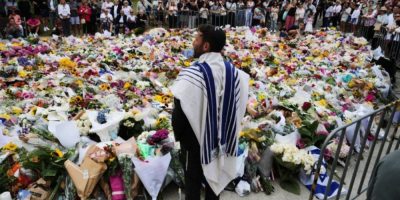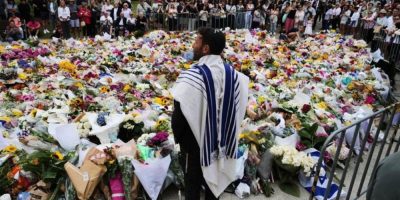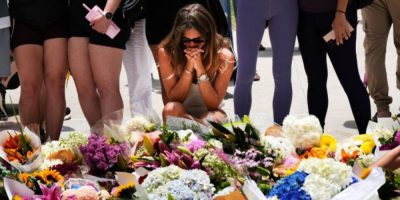
Updated September 24, 2024 @ 2:21pm
Israel said it killed a top commander with Hezbollah’s missile and rocket unit Tuesday as the Israeli military traded fire with Hezbollah again and the death toll from a massive Israeli bombing campaign climbed to nearly 560 people.
Thousands fled from southern Lebanon with the two sides on the brink of all-out war. In Beirut and the coastal city of Sidon, displaced families slept in shelters hastily set up in schools. With hotels quickly booked to capacity or rooms priced beyond the means of many families, those who did not find shelter slept in their cars, in parks or along the seaside.
Issa Baydoun fled the village of Shihine in southern Lebanon when it was bombed and drove to Beirut with his extended family. They slept in the vehicles on the side of the road after discovering the shelters were full.
“We struggled a lot on the road just to get here,” said Baydoun, who rejected Israel’s contention that it hit only military targets. “We evacuated our homes because Israel is targeting civilians and attacking them.”
The United Nations High Commissioner for Refugees in Lebanon said one of its staffers and her young son were among those killed Monday in the Bekaa region, while a UNHCR-contracted cleaner was killed in a strike in the south. The husband of a staffer and one of her children were seriously wounded.
Well-wishers offered empty apartments or rooms in their houses in social media posts. Volunteers set up a kitchen to cook meals for the displaced at an empty Beirut gas station that first became a hub for volunteers after the city's devastating 2020 port explosion.
In the eastern city of Baalbek, the state-run National News Agency reported that lines formed at bakeries and gas stations as residents rushed to stock up on essential supplies in anticipation of another round of strikes on Tuesday.
Meanwhile, the border crossing with Syria saw massive traffic jams as a result of people escaping from Lebanon to the neighboring country.
Tensions between Israel and the Lebanese militant group Hezbollah have steadily escalated over the last 11 months. Hezbollah has been firing rockets, missiles and drones into northern Israel in solidarity with the Palestinians and its ally Hamas, a fellow Iran-backed militant group, in Gaza.
Israel has responded with increasingly heavy airstrikes and the targeted killing of Hezbollah commanders while threatening a wider operation.
The Israeli military said Tuesday that an Israeli strike in Beirut had killed Ibrahim Kobeisi, who it said was a top commander with the group's rocket and missile unit. Military officials said Kobeisi joined Hezbollah in the 1980s, was responsible for launches towards Israel and planned a 2000 attack in the Mount Dov region in which three Israeli soldiers were kidnapped and killed.
It was the latest in a string of assassinations and setbacks for Hezbollah, the strongest political and military actor in Lebanon and widely considered the top paramilitary force in the Arab world. The militant group offered no immediate comment on the Israeli claims.
Lebanon’s Health Ministry said six people were killed and 15 were wounded in the strike in a southern Beirut suburb, an area where Hezbollah has a strong presence. The country’s National News Agency said the attack destroyed three floors of a six-story apartment building.
Hezbollah said it launched missiles at eight sites in Israel, including an explosives factory in Zichron Yaakov, 60 kilometers (37 miles) from the border.
The Israeli military said Tuesday morning that 55 rockets were fired from Lebanon into northern Israel, setting fires and damaging buildings.
Israeli military officials said they carried out dozens of airstrikes on Hezbollah targets, including on a cell that fired rockets overnight, and that tanks and artillery struck targets near the border.
The renewed exchange came after Monday's barrages racked up the highest death toll in any single day in Lebanon since Israel and Hezbollah fought a bruising monthlong war in 2006.
On Tuesday, mourners carried 11 bodies through the streets of the Lebanese village of Saksakieh, some 40 kilometers (25 miles) north of the Lebanon-Israel border, including those of four women, an infant and an 7-year-old girl. All were killed in Israel’s bombardment of the village Monday.
Some of the bodies were draped in Hezbollah flags, others wrapped in black clothes. A wreath of flowers was placed on top of the smallest one.
Mohammad Halal, father of 7-year-old Joury Halal, said his daughter was an “innocent child martyr.”
“She is a martyr for the sake of the south and Palestine,” Halal said and defiantly stated his allegiance to Hezbollah leader Hassan Nasrallah.
Israel said it targeted sites where Hezbollah had stored weapons. Data from American fire-tracking satellites analyzed Tuesday by The Associated Press showed the wide range of Israeli airstrikes aimed at southern Lebanon, covering an area of over 1,700 square kilometers (650 square miles).
NASA’s Fire Information for Resource Management System typically is used to track wildfires in the U.S. However, it can also be used to track the flashes and burning that follow airstrikes. Data from Monday showed significant fires across southern Lebanon and in the Bekaa Valley.
Thousands fled southern Lebanon on Monday after the Israeli military ordered people to evacuate areas where it accuses Hezbollah of positioning rocket launchers and other weapons, in the biggest exodus since the war waged 18 years ago.
The Lebanese Health Ministry said the strikes since Monday killed at least 558 people, including 50 children and 94 women, and wounded more than 1,800 people — a staggering toll for a country still reeling from a deadly attack on communication devices last week.
Nearly a year of cross-border fire had already emptied out communities near the border, displacing tens of thousands of people on both sides. Israel has vowed to do whatever it takes to ensure its citizens can return to their homes in the north, while Hezbollah has said it will keep up its rocket attacks until there is a cease-fire in Gaza, which appears increasingly remote.
The Israeli military says it has no immediate plans for a ground invasion but is prepared for one, after moving thousands of troops who had been serving in Gaza to the northern border. It says Hezbollah has launched some 9,000 rockets and drones into Israel since last October, including 250 on Monday alone.
The military said Israeli warplanes struck 1,600 Hezbollah targets Monday, destroying cruise missiles, long- and short-range rockets and attack drones, including weapons concealed in private homes.
Israel estimates Hezbollah has some 150,000 rockets and missiles, including guided missiles and long-range projectiles capable of striking anywhere in Israel.
Monday's escalation came after a particularly heavy exchange of fire Sunday. Hezbollah launched around 150 rockets, missiles and drones into northern Israel in retaliation for strikes that killed a top commander and dozens of fighters.
Last week, thousands of communications devices, used mainly by Hezbollah members, exploded in different parts of Lebanon, killing 39 people and wounding nearly 3,000, many of them civilians. Lebanon blamed Israel, but Israel did not confirm or deny responsibility.
___
Melzer contributed from Tel Aviv, Israel. Associated Press writers Jon Gambrell in Dubai, United Arab Emirates; Bassem Mroue and Fadi Tawil in Beirut; Julia Frankel in Jerusalem; and Emad Haddad in Saksakieh, Lebanon, contributed to this report.





